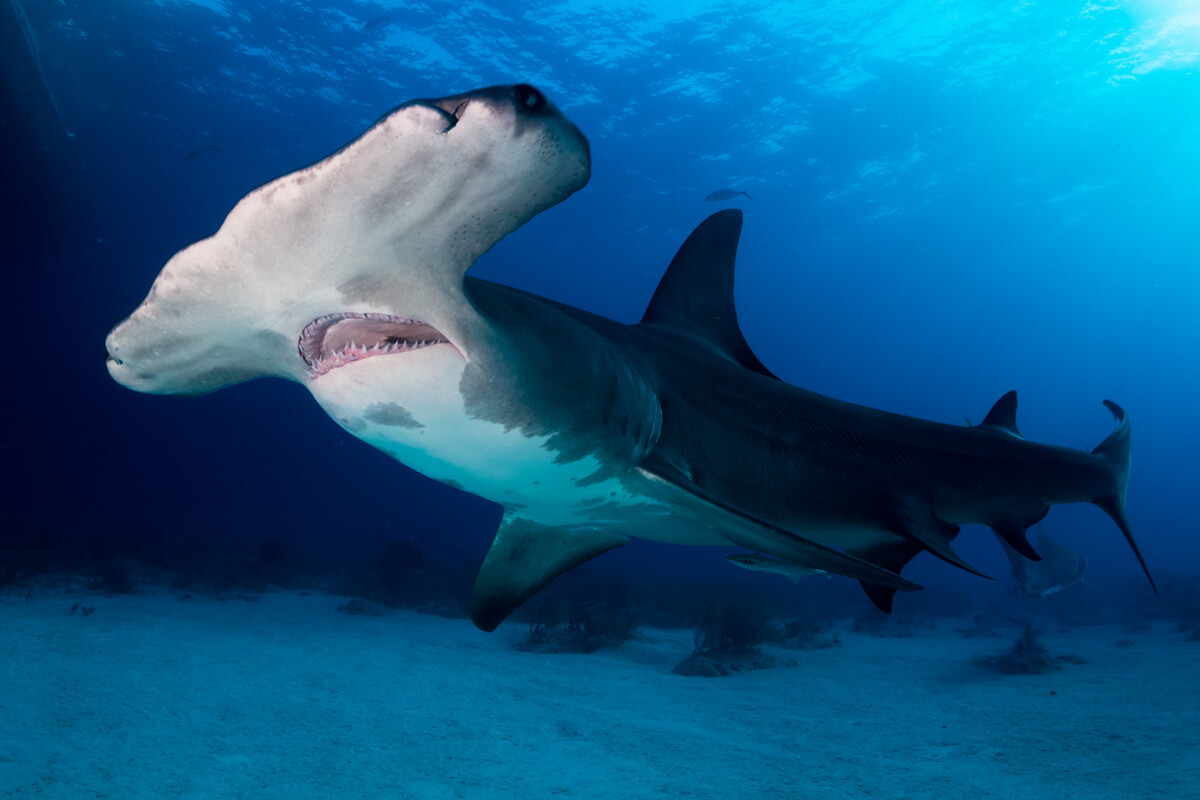Great Hammerhead Shark: Habitat and Characteristics

The great hammerhead shark is the largest of the 3 species of hammerhead sharks. Although the characteristic “T” shaped head it carries isn’t unique, its appearance can be easily recognized by the size of its first dorsal fin. Despite their ferocious appearance, these organisms are threatened by bycatch and trade in their fins.
Specifically, in this article, we’re going to refer to the species Sphyrna mokarran, which, in turn, is part of the sphyrnid family, better known as “hammerhead sharks”. No matter how big and strange it is, we mustn’t forget that it’s a cartilaginous fish. Read on to learn more about this gigantic and peculiar animal.
Great hammerhead shark habitat
This huge animal inhabits the tropical areas of the ocean along the coasts, continental shelves and lagoons of coral atolls. In addition, it’s a migratory species that travels north during the summer, preferring waters close to the surface and no more than 80 meters deep (260 feet)
Physical characteristics
The great hammerhead shark can reach sizes of up to 6 meters (20 feet) in length. However, it’s rare to see such large specimens, and their usual size is around 4 meters (13 feet). Likewise, the average weight of an adult specimen is usually greater than 500 kilos (1100 pounds), the females being larger and heavier than the males.
Regarding its appearance, the first dorsal fin is very tall and pointed, while the second is reduced. On the other hand, its anal fin has the typical “V” shape, with the upper part longer than the lower one. In addition, the body of this shark shows a brownish-gray coloration on the back with a light belly, which is an adaptation for catching prey.
The main characteristic of this shark is the hammer-shaped head that maintains a “T” appearance, with the eyes and nostrils located at the ends. This particular trait is what causes its “wiggly” swim, as it needs to move its head structure from one side to the other to be able to check the surroundings with its eyes.

Species behavior
This solitary, nomadic species has one of the most efficient swims among sharks. The way in which it manages to reduce its expenditure is extraordinary, as it swims “lying down“ in order to reduce water resistance. In fact, this is only possible thanks to its large dorsal fin, which allows it to reduce up to 10% of the energy it uses to swim.
On the other hand, this shark’s head has two important functions. The first is the reception of odors and the second is to help it hunt its prey. In the first point, its shape allows it to be used as an antenna, with which it can receive and locate the odors of its prey just by turning it a little. Also, during hunting, the shark uses its head to guide its prey to the bottom and attack them.
Great hammerhead shark feeding
This shark is a predator par excellence and its diet is made up of a wide variety of prey. Some of its natural victims include crabs, lobsters, squid, octopus, fish, and even some small sharks. For this reason, its teeth are pointed and sharp, as it has to cope with the hard skin of some of its prey.
Reproduction of the great hammerhead shark
Great hammerhead sharks are a viviparous species whose gestation lasts approximately 11 months. In addition, this organism is considered to have a biannual reproductive cycle that ends with giving birth between the months of July and September. The female gives birth to between 6 and 42 young, approximately, and the small specimens are born with sizes of 46 to 70 centimeters (1.5 to 2.3 feet).
Each of these offspring will reach sexual maturity after 8 years of age, because this is when they reach sizes greater than 2 meters (6.6 feet). In fact, some of them are grouped in nursery areas, in which their predators are few and they can grow faster.
These sites help newborns and juveniles improve their chances of survival to maturity.
State of conservation
According to the International Union for Conservation of Nature, this shark is classified as a critically endangered species. This situation is an indirect consequence of commercial fishing, as it’s common to catch hammerheads by mistake. In addition, these fish are also highly valued in competitive fishing, as they are often considered excellent trophies.
Currently, there are different laws that regulate the hunting and sale of these animals. However, many of these actions haven’t yet taken effect, as the populations of these specimens have continued to decline for years. In the end, the conflict they face is also a social one, as the consumption of shark meat and fins is ingrained in many cultures.
Shark fin soup is a highly prized dish in regions like China.
This doesn’t mean that all is lost for this species, but just that we are on full alert to avoid its extinction. The information that exists on this shark is scarce, which makes it difficult to formulate a plan that benefits its population. For this reason, before venturing to protect the species, it’s important to get to know its situation in depth.
All cited sources were thoroughly reviewed by our team to ensure their quality, reliability, currency, and validity. The bibliography of this article was considered reliable and of academic or scientific accuracy.
- Chapman, B. (2017). Shark Attacks: Myths, Misunderstandings and Human Fear. CSIRO PUBLISHING.
- Strong, W. R., Snelson, F. F., & Gruber, S. H. (1990). Hammerhead shark predation on stingrays: an observation of prey handling by Sphyrna mokarran. Copeia, 1990(3), 836-840.
- Cliff, G. (1995). Sharks caught in the protective gill nets off Kwazulu-Natal, South Africa. 8. The great hammerhead shark Sphyrna mokarran (Rüppell). South African Journal of Marine Science, 15(1), 105-114.
- Roemer, R. P., Gallagher, A. J., & Hammerschlag, N. (2016). Shallow water tidal flat use and associated specialized foraging behavior of the great hammerhead shark (Sphyrna mokarran). Marine and freshwater behaviour and physiology, 49(4), 235-249.
- Stevens, J. D., & Lyle, J. M. (1989). Biology of three hammerhead sharks (Eusphyra blochii, Sphyrna mokarran and S. lewini) from northern Australia. Marine and Freshwater Research, 40(2), 129-146.
- Macdonald, C., Jerome, J., Pankow, C., Perni, N., Black, K., Shiffman, D., & Wester, J. (2021). First identification of probable nursery habitat for critically endangered great hammerhead Sphyrna mokarran on the Atlantic Coast of the United States. Conservation Science and Practice, e418.
This text is provided for informational purposes only and does not replace consultation with a professional. If in doubt, consult your specialist.